Following on my previous post, I have finished installing Vista on Paralles. There were various things I had to do to succesully finish the upgrade:
- Expand the size of my virtual disk to at least 15 GB. The Vista installer will expand various files and needs this space
- Increase the memory size of the VM to 512
- Upgrade to the latest version of Parallels and use the menu that allows Vista in believing that the machine is OK to install Vista:
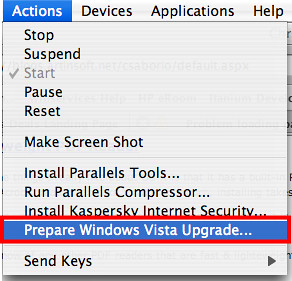
First off, all my applications worked after the upgrade, I was very impressed about this fact. On the other hand (I don't know if this is a Vista or Parallels issue), things are kind of slow. Windows XP running with 256 MB of RAM ran a lot faster than Vista with 512 MB of RAM. It seems like my CPU usage is higher when using Vista under Parallels.
These issues have me revert to Windows XP, which I will keep using until an upgrade for either Vista or Parallels that address this issue is released.
At this point, Parallels is one of the key players when it comes to virtualizing any x86 operating system on OS X. I use it on daily basis and cannot live without it.
VMWare has been working on its own version of the VMPlayer for OS X, called Fusion. The Betas that I have worked with have been not that impressive in terms of performance. VMWare claims that some of the sluggishness comes from debug code embedded into the application. On the other hand, Fusion offers some innovative features:
- Support for 64-bit VMs
- Ability to assign a CPU/core to the host, and the other to the program
Recently they have upgraded their beta to support 3-D acceleration directly from the graphics card. This means that very soon, Mac users will be able to play 3-D games on Windows within OS X. Considering that the list of Mac games is extremely short, this will really make things interesting for the Mac gaming market. There is a video on YouTube that has a demo of the application running:
http://www.youtube.com/watch?v=xF_CoXsXtk4
Your move, Parallels ;)
One of the things I really like about OS X is that it has a built-in PDF Viewer. What's so special about this PDF viewer? I think what I like the most is the fact that it is not bloated. Adobe's Acrobat reader can take a while to launch, installing takes around 20 MB of downloads, and on older machines can really perform poorly.
I stumbled upon Sumatra PDF over the weekend, and I think it is a great replacemente for Adobe's Reader in Windows. I think you cannot beat Sumatra, especially when it comes to the price (free!)
Do you know of any other PDF readers that are fast & lighteweight?
So what is the story with Vista? You've read the hype, you've seen the reviews but I bet not many have messed around with it. I will take challenge and not only install, but upgrade my current Windows XP virtual machine running in Parallels to Ultimate Vista.
Basically I am doing this because I do not want to install Vista on a clean image and have to reinstall all the software that would require re-configuration. What I have on my VM that I hope does not break in Vista is the following:
- Live Writer
- Visual Studio 2005
- Office 2004
- Visual Source Safe
Not to bad huh? I will keep posting my progress made when moving to the new OS by Microsoft.
As of now, I have just upgraded to the latest Parallels version which should let me upgrade to Vista...launch the installer and TADA:
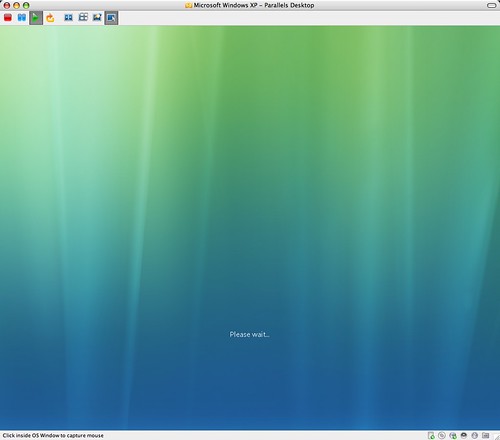
One click after I get my first obstacle:
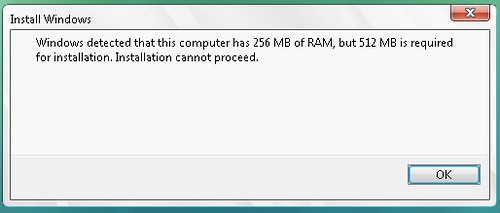
Turning off VM and increasing memory...BBL
Yesterday, one of the attendees from the
Virtualization events asked this question which I though would be worthwhile to share:
For a simple .NET application like this, would we need different applications when running on 64 vs. 32 bit hosts?
Before answering, please allow me to elaborate more on where the question is going. Virtual Server has a COM API that allows it to be managed by applications and scripts. Virtual Server R2 SP1 Beta 2 (phew) comes in two flavors: 32-bit and 64-bit. The owner of the question wondered if you could manipulate a 64-bit instance of Virtual Server using a 32-bit application (or vice-versa).
Ok, now that the question is (hopefully) a bit clearer, the answer to the question is
no, you do not need to have a different version for accessing Virtual Server from an application regardless of its bit-architecture. Why? Virtual Server's COM API is accessed by an out-of-process COM library, which means that everything is done by means of RPC. When two applications are communicating with each other by means of RPC, the 1st commandment of 64-bit is
not broken (thou shall not run 32-bit and 64-bit code within the same process space).
Riddle me this: How many licenses of Windows Server Enterprise Edition would you need if you are planning on running 20 Virtual machines inside a server that has 2 processors? Very, easy, you would need only 5 licenses. Too tough? How about this one...what would be the price difference if you were running 50 machines running Windows Server 2003 on a virtualization server with 2 processors if you chose to run the host machine with Windows Server Enterprise Edition vs. Windows Server Datacenter Edition? Very easy...running Datacenter edition would be $25,580 cheaper.
It definitely is tempting to say that I can pull this info right off the top of my head, but that would be a big big lie. The secret lies in the sweet web application Microsoft has published. It is called the
Windows Server Virtualization Calculator, and without a doubt, it will clear a lot of doubts and will show you the best way to go (in terms of licensing) when consolidating your data center, enjoy!
Have you ever seen the Exit rows in an airplane? They longer leg space than coach, and after business or first, they are the best seats in the place. The bad news is that these seats are not reserved for anyone, or at least not in American Airlines. These seats are reserved for those travelers who have some kind of status such as Platinum or Gold. This means that if you do not have a status, you cannot choose them on-line (the seats will show up as unavailable), but fear not - I have found a workaround in some cases.
Say that you have no status at all in American Airlines, but you are traveling with a colleague or friend that does have this status. Before purchasing the ticket, you must tell your travel agent to place both tickets within the same record locator. The person with the high status will be able to select these exit rows for you and you will be able to fly a lot comfortable without having to have a high status.
Be warned that if 2 or more people are on the same American itinerary, and one of them selects an Upgrade to business, everyone in the itinerary will have a request to first. If they do not have enough upgrade stickers, the consequences can be quite bad - such as losing the exit row that was pre-selected and having to fly (if lucky) on the worst seat in the plane :S
There are many many alternatives out there that will assist you to migrate a Physical machine to a Virtual - heck, even NT Backup can be used to accomplish this. The supported procedure recommended to carry out this procedure is to use ADS to create an image of the source machine and then dump it to a Virtual Machine. I am currently testing this procedure and trust me, it is not a straightforward one.
Given the choice, I would recommend any other approach when carrying out a P2V migration. VMWare currently released they migration utility that allows to move physical machines to virtual ones. It even goes the extra mile and imports various virtual machines from other solutions such as Microsoft's Virtual Server.
This is perfect for users of VMWare, but what about if you want to carry a P2V migration to the Virtual Server format? Well, you can still carry this out by using VMWare's tool and then using this utility to convert from VMWare to Virtual Server format. Not the cleanest solution, but I guess this is a perfect example in which the ends justify the means ;)
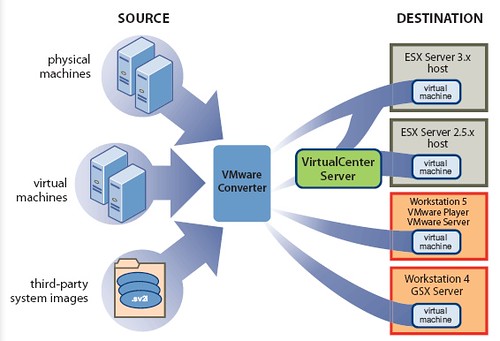
Before I get started on this blog post, allow me to say that this is something that you should never do in a production environment. That being said, when working with the Administrative Web Interface of Virtual Server, it will prompt you for username/password when you start the browser session and when you want to use VMRC to control a VM:
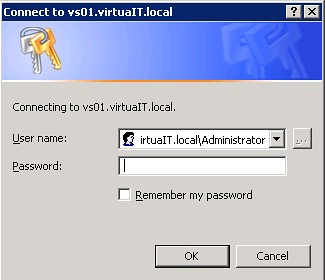
See that "Remember my password" checkbox? Well, it has never worked for us, and according to David Wang, this is an issue with the Virtual Server's Administrative Web Interface being accessed not as an Intranet site but rather as an Internet site. I tried messing with the security settings of my trusted site to allow the use of the currently logged on user on the sites - this lead me nowhere as the web site would not even show up.
I then proceeded to mess with some settings with IIS and I have achieved my purpose: no more password input every time I need to VMRC! . It is worth mentioning again that this is something I am doing on an isolated machine that we use for testing purposes - never, ever do this on a production machine!!!
Here is what you need to do:
- Access the IIS Control Panel
- Expand the following nodes: Virtual Server --> VirtualServer
- Right click on the VirtualServer node and select Properties
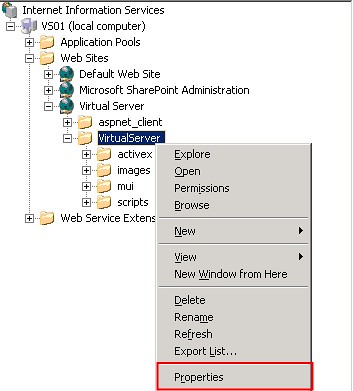
- Click on the Directory Security Tab
- Click the Edit button under Authentication and access control
- Mark the check labeled "Enable anonymous access"
- Enter a username/password combination that is allowed to access Virtual Server
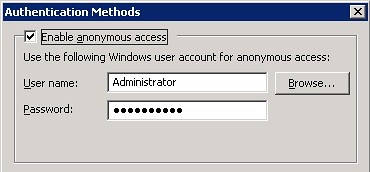
So far what you have done will allow you to access Virtual Servers main Administrative interface. If you want to skip the whole username/password issue when using VMRC, you must change some settings in IE:
- Access Internet Options from within IE
- Select the Trusted Sites Zone
- Click on Custom level
- Scroll all the way to the bottom and under User Authentication--> Logon, select "Automatic logon with current user name and password"
- Close the dialogs, restart IE
Once you do this, you will be able to access the Administrative Web Interface as the user you specified above. Nifty trick for testing but a big no-no for any other scenario.
If the tasks that your application carries out are independent of each other, a way to optimize things is to create threads for various tasks. There are many ways to thread applications including Pthreads, windows threading, and recently OpenMP. OpenMP excels in the sense that it can make your application multi-threaded by just writing a few pragmas here and there.
Once you multi-thread your application, many things can go astray. For instance, different threads can access variables at different intervals in a loop, which can only lead to disastrous results in your calculations. You can break your head and lose some of your sanity by manually debugging what is going wrong with your application or you can use Intel's thread checker to find out what is going on. For instance, the following sceenshot shows you the output of all the problems (referred to as data races) when various threads were accessing variables and changing them on each loop:
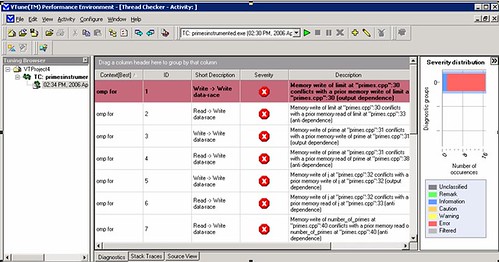
Furthermore, your application's threads might starve waiting for a particular resource to be freed, which can only make the whole multi-threading effort futile. Tools like Intel's thread profiler can help you find this info. For example, after data collection, based on the following screenshot, you can pretty much tell that due to locks in the code, the threads are pretty much stalling the application:

Now that you know what these two tools are and what they do, what I wanted to show you was how to get around the fact that none of these tools can be installed on a Itanium box. That is, now that the Itanium is dual-core, how do you go about optimizing multi-threaded apps using these tools? The solution to this problem will be included in the second part of this post, stay tuned!